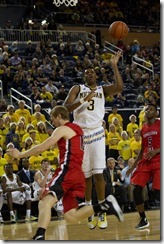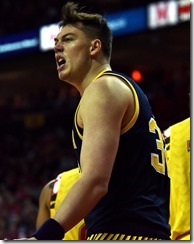Upchurch / Upchurch / Sherman
Previously: Zak Irvin, Muhammad-Ali Abdur-Rahkman, Duncan Robinson, Mark Donnal
With the news that Kam Chatman is transferring, what was a five-man rising junior class is now just two. Four players (including Spike – who will be playing for Purdue next season) who played last season are leaving with remaining eligibility. Ordinarily, this would be cause for considerable depth concerns, but since Michigan returns all five starters from last season’s tournament team – something that very few teams can say in this day and age – experience is actually an advantage for this team moving forward. Very rarely are teams able to sustain five-man lineups year over year and it’s reasonable to expect that Walton / Rahkman / Robinson / Irvin / Donnal will execute crisp offense together on the floor. If improvement from Wagner vaults him past Donnal (who’s much more of a known quantity) on the depth chart, all the better.
Right now, that depth chart might look like this:
We’ve seen the effect that limited depth can have on players, and it might be a concern again. Walton will have a very capable backup in Xavier Simpson, and fellow freshman Ibi Watson will get a shot behind MAAR, so the guard situation is much better than it was a year ago. There are enough big men: Donnal and Wagner will run into foul trouble, so there’s a need for a third option to emerge, but all in all, there are enough bodies at the five.
The main concern comes on the wing – and that’s why the departures of Dawkins and Chatman might be felt the most. Michigan has two open scholarships for next season and desperately could use a wing with immediate eligibility (either as ideally a grad transfer or a 2016 recruit) to offset those losses: Dawkins was Michigan’s sixth man and played just under 40% of available minutes, while Chatman chipped in 12%. By the postseason, both were essentially used only to rest the starters – Robinson and Irvin each played right around 90% of available minutes in the Wolverines’ five postseason games. As it stands, those two are the only wings left with any experience.
None of the departures – Aubrey Dawkins, Ricky Doyle, and Kam Chatman – are particularly unexpected; Dawkins fell behind Duncan Robinson and saw his dad take a mid-major coaching job; Doyle and Chatman were on the periphery of the rotation and a path to significant minutes for either was hard to find. Still, all three were good enough to play last year, and their minutes will need to be replaced. Doyle’s minutes will be split easily between Donnal, Wagner, and the freshmen bigs; Robinson and Irvin probably can’t handle many more minutes, let alone taking all the minutes vacated by Dawkins and Chatman.
[What will Michigan be losing? Find out after the JUMP]
From a statistical standpoint, it doesn’t look like Michigan’s losing anything it can’t replace. Dawkins was pretty efficient due to his three-point shooting; Doyle’s offensive rating was low for a Michigan center; Chatman (who had an enormous usage rate in his sparse minutes) really struggled shooting the ball – except for that one time.
I posted a similar graphic in Irvin’s season recap, as his data point is certainly the most eyebrow-raising. If his three-point percentage (29.8) improves to even an average level, his overall efficiency would take a mini-leap; of course, he shot the ball better after he’d fully recovered from his injury. Zak’s also the late-clock creator more often than not, and when Michigan’s struggling to get shots, he’s one of the few naturally aggressive shot-hunters on the team. Still, if Michigan’s to make a significant improvement next year, Zak will have to become more efficient in the lead role. I digress.
Here’s what Michigan’s losing with each departure:
Aubrey Dawkins
After a promising close to his freshman season, Aubrey Dawkins received the most hype as the “most improved player” over the summer (it turned out to be LeVert). Unfortunately for Dawkins, his skill-set overlapped almost completely with Duncan Robinson’s – both are shooters, neither are defenders – and his playing time went down as Robinson got off to a hot start shooting the ball. Dawkins never seemed to find his rhythm for Michigan this season, though there were a few games where he provided instant offense off the bench in the form of a succession of made threes.
Dawkins was a very effective shooter (56% on twos, 43% on threes, 74% on free throws) and actually shot 50% from three in Big Ten play, far better than Robinson’s 35%. Still, Duncan played far more, eventually becoming so entrenched in the rotation that Dawkins rarely had a shot to inject some life into Michigan’s offense with his shooting. The main culprit was, of course, defense. Perhaps no one better epitomized the struggles of Michigan basketball more than Dawkins did: he had some nice skills offensively (though his dunking never translated into the actual games), but any chance of meaningful contribution was torpedoed by his inattentive matador defense. We hoped that Aubrey would develop into a 3-and-D wing, but somehow it seemed as if his defense actually regressed.
Of course, with the lack of wing depth on the roster, it would have been great to have Dawkins back, even if his skill-set is redundant with Duncan on the roster. A knockdown shooter off the bench is usually a luxury, but Dawkins always needed to chip in a few threes to compensate for his defense. As Robinson became a better – though still not very good – defender, Dawkins’s playing time evaporated, even if he was shooting better than Robinson was. That’s why it’s really no surprise that’s joining his father at UCF – hopefully Aubrey can improve his defense, because if he does, he could be a great player for them.
Ricky Doyle
Doyle was the nominal winner of the battle at the five last year between he, Donnal, and Max Bielfeldt, but a year later, he was clearly the worst of the three.* Apparently he dealt with problems associated with sleep apnea, which would explain his seeming lack of energy and burst on the floor. Even when he was pretty successful as a freshman, it wasn’t because of his athleticism, so the problems that came along with sleeplessness and depression-like symptoms doubtlessly left Ricky struggling on the floor. Fortunately, he was diagnosed with the problem, so hopefully he’ll be able to eliminate his sleep apnea issues.
Once Mark Donnal emerged as a legit player against Illinois, Doyle’s playing time dropped off steeply – and after his grogginess during his start to the season, it wasn’t much of a surprise. Now that Moritz Wagner has shown flashes as a high-ceiling player, the writing was pretty much on the wall for Doyle, who also saw two incoming freshmen he’d have to battle for playing time (and as it’s usually wiser to develop young players, Doyle would have to play at a high level). It’s going to be interesting to see what school he transfers to and how he plays there after a redshirt season – Ricky was always a developmental guy and with his sleep issues in the past, he could be a real steal for a solid program, despite his athletic limitations.
*and Bielfeldt was clearly the best – a dynamic small-ball five who could moonlight as a four and who won Big Ten Sixth Man of the Year. He finally developed into what Beilein saw as his ceiling when he gave him a very late offer, but he fulfilled that promise for Indiana. At least Michigan went 1-1 against him.
Kam Chatman
Doyle – an early addition without any other major interest – and Dawkins – a late add whose best offer was Dayton – were under-the-radar recruits, but Chatman came in as the jewel of the class, a top 50 recruit. Kam never was able to adjust well to the faster pace of college hoops; as a freshman, he played 35.9% of available minutes but put up a really bad eFG% of 36.8. While his shooting improved a decent amount as a sophomore, his playing time went down and his overall efficiency still wasn’t very good, despite being a good passer for his size (assist rate of 14.2, higher than his turnover rate). Defensively, Kam was probably the best option on the wing, but it’s pretty clear that Beilein values players with good offense and poor defense far more than the inverse.
Any way you slice it, Chatman was a disappointment relative to his lofty recruiting rankings. Whether it was his youth (relative to his Class of 2016 peers) or a more unorthodox set of skills, it was hard for him to gel with his teammates and Beilein’s system. It was long assumed that he was Michigan’s most likely transfer, though during the time between Dawkins’s departure and Kam’s, it looked like he could be in for Dawkins’s minutes. In any case, the redshirt year should also benefit Chatman, who was put onto the floor far too early. He was a very sought-after recruit the first time around, and I wonder if that will linger as his second recruitment begins.
* * *
The biggest impact of these transfers, in the short-term, is the vacancy at wing – something that may or may not change as the roster for next season is finalized. If no other wing is added, perhaps MAAR could give some minutes at the three, though putting him, an undersized four, and a tiny backcourt on the floor at the same time may not be tenable. In the long term, these moves clear up room – instead of five players seeing their eligibility expire after 2018, there are now just two (and DJ Wilson, who could get a redshirt senior season for 2018-19).





















